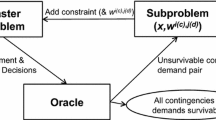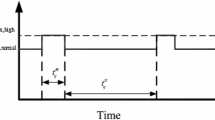Abstract
There is currently a national push to create a smarter, more flexible electrical grid. Traditionally, network branches (transmission lines and transformers) in the electrical grid have been modeled as fixed assets in the short run, except during times of forced outages or maintenance. This traditional view does not permit reconfiguration of the network by system operators to improve system performance and economic efficiency. However, it is well known that the redundancy built into the transmission network in order to handle a multitude of contingencies (meet required reliability standards, i.e., prevent blackouts) over a long planning horizon can, in the short run, increase operating costs. Furthermore, past research has demonstrated that short-term network topology reconfiguration can be used to relieve line overloading and voltage violations, improve system reliability, and reduce system losses. This chapter discusses the ways that the modeling of flexible transmission assets can benefit the multi-trillion dollar electric energy industry. Optimal transmission switching is a straightforward way to leverage grid controllability; it treats the state of the transmission assets, i.e., in service or out of service, as a decision variable in the optimal power flow problem instead of treating the assets as static assets, which is the current practice today. Instead of merely dispatching generators (suppliers) to meet the fixed demand throughout the network, the new problem co-optimizes the network topology along with generation. By harnessing the choice to temporarily take transmission assets out of service, this creates a superset of feasible solutions for this network flow problem; as a result, there is the potential for substantial benefits for society even while maintaining stringent reliability standards. On the contrary, the benefits to individual market participants are uncertain; some will benefit and other will not. Consequently, this research also analyzes the impacts that optimal transmission switching may have on market participants.
Access this chapter
Tax calculation will be finalised at checkout
Purchases are for personal use only
Similar content being viewed by others
Notes
- 1.
See Sec.1223.a.5 of the US Energy Policy Act of 2005.
- 2.
N-k reliability means that the system can survive the simultaneous failure of any k elements without violating any constraints on the surviving network and without the need for load shedding.
- 3.
In reality, generator cost functions are quadratic in output (aside from startup and no load costs); however, in practice, such cost functions are approximated by piecewise linear functions represented as block offers at different marginal prices. The DCOPF formulation with piecewise linear cost functions is also a linear programming problem.
- 4.
The unconstrained economic dispatch problem is a dispatch problem without transmission network constraints.
- 5.
Ideally, unit commitment models would endogenously represent all N-1 contingencies. Instead, reserve constraints are generally used as surrogates since solving a unit commitment problem while modeling every single contingency is computationally very challenging. The research in [16] modeled this much more robust and difficult problem since there is the underlying question as to whether reserve requirements created for the original topology will work for the reconfigured topology, which is a topic for future research as indicated in Sect. 6.2.
References
Glavitsch H (1985) State of the art review: switching as means of control in the power system. INTL JNL Elect Power Energy Syst 7(2):92–100
Mazi AA, Wollenberg BF, Hesse MH (1986) Corrective control of power system flows by line and bus-bar switching. IEEE Trans Power Syst 1(3):258–264
Gorenstin BG, Terry LA, Pereira MVF et al (1986) Integrated network topology optimization and generation rescheduling for power system security applications. IASTED INTL SYMP: High Tech Power Ind 1:110–114
Bacher R, Glavitsch H (1986) Network topology optimization with security constraints. IEEE Trans Power Syst 1(4):103–111
Bakirtzis AG, Meliopoulos AP (1987) Incorporation of switching operations in power system corrective control computations. IEEE Trans Power Syst 2(3):669–675
Schnyder G, Glavitsch H (1988) Integrated security control using an optimal power flow and switching concepts. IEEE Trans Power Syst 3(2):782–790
Schnyder G, Glavitsch H (1990) Security enhancement using an optimal switching power flow. IEEE Trans Power Syst 5(2):674–681
Rolim JG, Machado LJB (1999) A study of the use of corrective switching in transmission systems. IEEE Trans Power Syst 14:336–341
Shao W, Vittal V (2005) Corrective switching algorithm for relieving overloads and voltage violations. IEEE Trans Power Syst 20(4):1877–1885
Shao W, Vittal V (2006) BIP-based OPF for line and bus-bar switching to relieve overloads and voltage violations. PSCE 2006 1:2090–2095
Granelli G, Montagna M, Zanellini F et al (2006) Optimal network reconfiguration for congestion management by deterministic and genetic algorithms. Electr Power Syst Res 76(6–7):549–556
Bacher R, Glavitsch H (1988) Loss reduction by network switching. IEEE Trans Power Syst 3(2):447–454
Fliscounakis S, Zaoui F, Simeant G et al (2007) Topology influence on loss reduction as a mixed integer linear programming problem. IEEE Power Tech 1:1987–1990
ISONE (2007) ISO New England Operating Procedure no. 19. Transm Oper 1:7–8
Northeast Power Coordinating Council (1997) Guidelines for inter-area voltage control. NPCC Operating Procedure Coordinating Committee and NPCC System Design Coordinating Committee, New York
PJM (2010) Manual 3: transmission operations, revision: 35, October 5, 2009. Section 5: index and operating procedures for PJM RTO Operation. PJM. http://www.pjm.com/markets-and-operations/compliance/nerc-standards/~/media/documents/manuals/m03.ashx. Accessed 1 Sep 2010
ISONE (2010) ISO New England Outlook: Smart Grid is About Consumers. ISONE http://www.iso-ne.com/nwsiss/nwltrs/outlook/2009/outlook_may_2009_final.pdf. Accessed 1 Sep 2010
O’Neill RP, Baldick R, Helman U et al (2005) Dispatchable transmission in RTO markets. IEEE Trans Power Syst 20(1):171–179
Fisher EB, O’Neill RP, Ferris MC (2008) Optimal transmission switching. IEEE Trans Power Syst 23(3):1346–1355
Hedman KW, O’Neill RP, Fisher EB et al (2008) Optimal transmission switching – sensitivity analysis and extensions. IEEE Trans Power Syst 23(3):1469–1479
Hedman KW, O’Neill RP, Fisher EB et al (2009) Optimal transmission switching with contingency analysis. IEEE Trans Power Syst 24(3):1577–1586
Hedman KW, Ferris MC, O’Neill RP et al (2010) Co-optimization of generation unit commitment and transmission switching with N-1 reliability. IEEE Trans Power Syst 25(2):1052–1063
Hedman KW, O’Neill RP, Fisher EB et al (2010) Smart flexible just-in-time transmission and flowgate bidding. IEEE Trans Power Syst 26(1):93–102
Hedman KW, Oren SS, O’Neill RP (2010) Optimal transmission switching: economic efficiency and market implications. JNL Reg Econ. 40(2):111–140
O’Neill RP, Hedman KW, Krall EA et al (2010) Economic analysis of the N-1 reliable unit commitment and transmission switching problem using duality concepts. Eneregy Syst 1(2):165–195
Bergen A, Vittal V (2000) Power systems analysis, vol 2. Prentice Hall, Upper Saddle River
Hogan WW (1992) Contract networks for electric power transmission. J Reg Econ 4:211–242
PowerWorld Corporation(2010) PowerWorld simulator – optimal power flow analysis tool. http://www.powerworld.com/products/opf.asp. Accessed 3 Nov 2010
Ziena Optimization Inc (2010) Knitro optimization software. http://www.ziena.com/knitro.htm. Accessed 3 Nov 2010
Author information
Authors and Affiliations
Editor information
Editors and Affiliations
Appendices
Appendix
Notation | |
Indices and Sets | |
g | Generator |
g(n) | Set of generators at bus n |
k | Transmission element (line or transformer) |
k(n,.), k(.,n) | Set of transmission elements with bus n as the to bus and the set with bus n as the from bus respectively |
m, n | Nodes |
Parameters | |
B k | Susceptance of transmission element k |
c g | Production cost for generator g |
d n | Real power load at node n |
G k | Conductance of transmission element k |
M k | Big M value for transmission element k |
P g max , P g min | Max and min capacity of generator g |
P k max , P k min | Max and min rating of transmission element k; typically P k max = -P k min |
θ max , θ min | Max and min bus voltage angle difference; typically θ max = -θ min |
θ rec | Max voltage angle difference when reclosing breakers to bring a line back into service |
Variables | |
P g | Real power supply from generator g at node n |
P k | Real power flow from node m to node n for transmission element k |
Q k | Reactive power flow from node m to node n for transmission element k |
V n | Bus voltage at node n |
z k | Binary switching variable for transmission element k (0 open/not in service, 1 closed/in service) |
γ k | Bus voltage angle variable that is equal to transmission element k’s to bus angle value when the line is in service but equal to transmission element k’s from bus angle value when the line is out of service |
θ n | Bus voltage angle at node n |
Biographies
Kory W. Hedman received the B.S. degree in electrical engineering and the B.S. degree in economics from the University of Washington, Seattle, in 2004 and the M.S. degree in economics and the M.S. degree in electrical engineering from Iowa State University, Ames, in 2006 and 2007, respectively. He received the M.S. and Ph.D. degrees in industrial engineering and operations research from the University of California, Berkeley in 2007 and 2010 respectively.
Currently, he is an assistant professor in the school of electrical, computer, and energy engineering at Arizona State University. He previously worked for the California ISO (CAISO), Folsom, CA, on transmission planning and he has worked with the Federal Energy Regulatory Commission (FERC), Washington, DC, on transmission switching.
Shmuel S. Oren received the B.Sc. and M.Sc. degrees in mechanical engineering and in materials engineering from the Technion Haifa, Israel, and the MS. and Ph.D. degrees in engineering economic systems from Stanford University, Stanford, CA, in 1972.
He is a Professor of IEOR at the University of California at Berkeley and the Berkeley site director of the Power System Engineering Research Center (PSERC). He has published numerous articles on aspects of electricity market design and has been a consultant to various private and government organizations including the Public Utilities Commission of Texas, The Energy Division of the California Public Utilities Commission, The California ISO and The Bonneville Power Authority. Dr. Oren is a Fellow of INFORMS and of the IEEE.
Richard P. O’Neill has a Ph.D. in operations research and a BS in chemical engineering from the University of Maryland at College Park.
Currently, he is the Chief Economic Advisor in the Federal Energy Regulatory Commission (FERC), Washington, D.C. He was previously on the faculty of the Department of Computer Science, Louisiana State University and the Business School at the University of Maryland at College Park.
Rights and permissions
Copyright information
© 2012 Springer-Verlag Berlin Heidelberg
About this chapter
Cite this chapter
Hedman, K.W., Oren, S.S., O’Neill, R.P. (2012). Flexible Transmission in the Smart Grid: Optimal Transmission Switching. In: Sorokin, A., Rebennack, S., Pardalos, P., Iliadis, N., Pereira, M. (eds) Handbook of Networks in Power Systems I. Energy Systems. Springer, Berlin, Heidelberg. https://doi.org/10.1007/978-3-642-23193-3_21
Download citation
DOI: https://doi.org/10.1007/978-3-642-23193-3_21
Published:
Publisher Name: Springer, Berlin, Heidelberg
Print ISBN: 978-3-642-23192-6
Online ISBN: 978-3-642-23193-3
eBook Packages: Mathematics and StatisticsMathematics and Statistics (R0)




